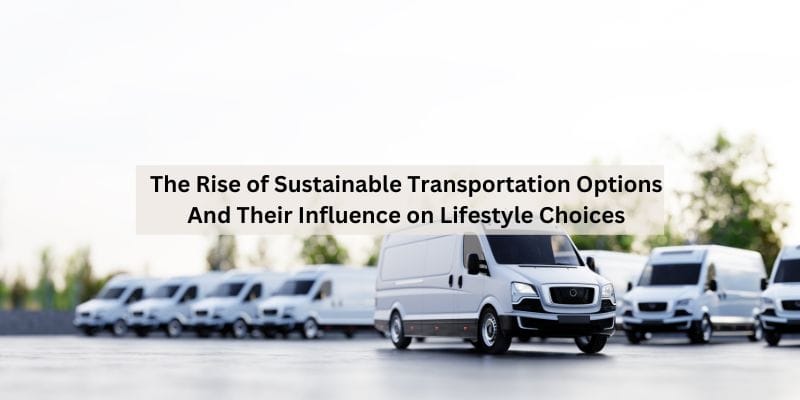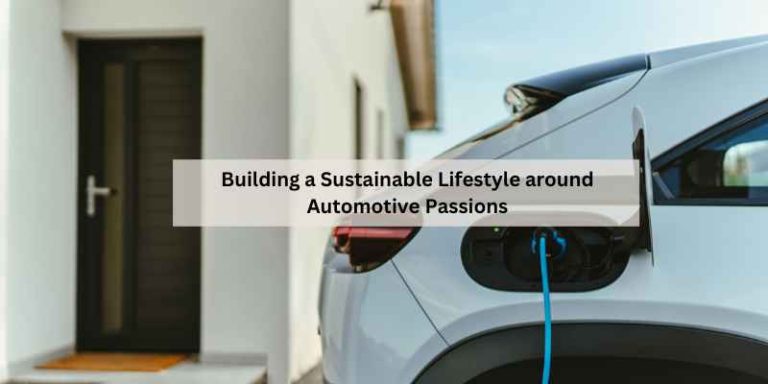The Rise of Sustainable Transportation Options And Their Influence on Lifestyle Choices
The rise of sustainable transportation options is influencing lifestyle choices, as people are increasingly opting for low- or zero-emission modes of transport to reduce traffic congestion, improve air quality, and lower greenhouse gas emissions. These choices include electric vehicles, bicycles, and carpooling, which not only benefit the environment but also promote healthier and more active lifestyles.
As sustainable transportation infrastructure continues to develop, it offers future generations the opportunity to reduce their environmental footprint and address economic, social, and environmental challenges. By embracing sustainable transportation, individuals can make a positive impact on the planet and contribute to a more sustainable and greener future.
The Shift Towards Green Mobility
The rise of sustainable transportation options is influencing lifestyle choices globally. Eco-friendly vehicles are gaining momentum, promoting a green makeover in public transport. Sustainable transportation aims to reduce traffic congestion, improve urban air quality, and lower outdoor air pollution. It also seeks to decrease global greenhouse gas emissions and the reliance on fossil fuels. Sustainable transportation includes low- and zero-emission vehicles, energy-efficient modes of transport, and the use of alternative fuels. This shift towards green mobility is crucial in addressing economic, social, and environmental challenges, especially in the post-COVID era. Rethinking and revamping transportation infrastructure can significantly impact everyday lives, contributing to a more sustainable future for generations to come.
Cycling: The Two-wheeled Revolution
The rise of sustainable transportation options has brought about a significant shift in lifestyle choices. The expansion of urban bike lanes has made cycling a more appealing and feasible mode of transportation in cities. Additionally, the introduction of bicycle sharing systems has further promoted the use of bicycles as an eco-friendly and convenient means of getting around urban areas.
Electric Vehicles: Sparking Change
“Electric Vehicles: Sparking Change” explores the growing impact of sustainable transportation on lifestyle choices. With the rise of electric and alternative-fuel vehicles, individuals are embracing environmentally-friendly modes of transport, contributing to reduced air pollution and greenhouse gas emissions while influencing urban living.
Advancements in EV technology have paved the way for a sustainable future. With zero emissions and low maintenance, electric vehicles are becoming a popular choice for commuters. Government incentives for EV adoption, such as tax credits and rebates, have also encouraged individuals to make the switch. This shift towards sustainable transportation options not only benefits the environment by reducing greenhouse gas emissions and air pollution, but also has a positive impact on our daily lives. By decreasing traffic congestion, we save time and money on commuting. Additionally, the availability of charging stations in public areas and workplaces makes it convenient for EV owners to charge their vehicles on the go. The rise of sustainable transportation options is not just a trend, but a necessary step towards a greener future.
Carpooling And Ride-sharing
Apps like Uber and Lyft have been instrumental in driving the carpool culture, making it convenient for people to share rides and split costs. This not only reduces the number of vehicles on the road but also contributes to improved traffic flow and better air quality. By encouraging more people to share rides, these apps are playing a significant role in promoting sustainable transportation options.
Sustainable Transportation’s Impact On Urban Life
|
The rise of sustainable transportation options has brought significant changes to the way urban residents lead their lives. With the increasing popularity of low- and zero-emission, energy-efficient, and affordable modes of transport such as electric and alternative-fuel vehicles, bicycles, and carpooling, traffic congestion has been reduced, resulting in a smoother flow of traffic and less idling time for vehicles, which in turn saves money and energy. Furthermore, sustainable transportation has contributed to improving urban air quality by reducing outdoor air pollution and the use and reliance on fossil fuels, ultimately reducing global greenhouse gas emissions. By making sustainable transportation choices, we can positively impact the environment and our everyday lives. Examples of sustainable transportation choices include electric vehicles, bicycles, and carpooling. Electric vehicles are another environmentally-friendly form of transport, while cycling provides a good workout and helps conserve the planet. Carpooling is also a great option, as it reduces the number of vehicles on the road and helps to decrease traffic congestion. Sustainable transportation infrastructure is the way forward for future generations to reduce their environmental footprint. With more sustainable transportation options available, we can continue to make positive changes in the world around us. |
Challenges On The Road To Sustainability
Sustainable transportation options have become increasingly popular in recent years due to their positive impact on the environment and urban residents. However, several challenges exist on the road to sustainability, including infrastructure hurdles and public perception and habits.
| Infrastructure hurdles | Public perception and habits |
|---|---|
| Developing a sustainable transportation infrastructure requires significant investment and planning. | Many people are resistant to change and prefer traditional modes of transportation, such as driving alone. |
| Infrastructure must be designed to accommodate different types of sustainable transportation, including electric vehicles and public transit. | There is a lack of awareness about the benefits of sustainable transportation, which can lead to skepticism and resistance. |
| Existing infrastructure may need to be retrofitted or redesigned to accommodate sustainable transportation options. | Habits are hard to break, and many people are accustomed to the convenience and independence of driving alone. |
Despite these challenges, sustainable transportation options offer numerous benefits, including reduced traffic congestion, improved air quality, and lower greenhouse gas emissions. By investing in sustainable transportation infrastructure and promoting public education and awareness, we can overcome these challenges and create a more sustainable future for all.
The Role Of Policy In Sustainable Transportation
The role of policy in sustainable transportation is crucial for driving positive change. Government regulations and policies play a significant role in shaping the landscape of transportation options. Local initiatives and community support further reinforce the impact of these policies, creating a conducive environment for the growth of sustainable transportation. By implementing supportive policies and regulations, governments can encourage the adoption of environmentally-friendly modes of transport, leading to a reduction in traffic congestion and air pollution. These measures also contribute to a decrease in reliance on fossil fuels, thereby promoting energy efficiency and sustainability. Furthermore, community-driven initiatives play a vital role in fostering a culture of responsible transportation choices, influencing individuals to opt for more sustainable methods of travel.
Looking Ahead: The Future Of Sustainable Transport
The rise of sustainable transportation options has a significant impact on the lifestyle choices of people worldwide. Innovations on the horizon, such as low- and zero-emission vehicles, energy-efficient modes of transport, and affordable alternatives, have paved the way for a more sustainable future. Public engagement plays a crucial role in driving the adoption of sustainable transportation options, as it raises awareness and promotes the benefits of a cleaner and healthier environment.
Frequently Asked Questions
How Does Sustainable Transport Affect Our Everyday Lives?
Sustainable transport reduces traffic, air pollution, and reliance on fossil fuels, improving urban air quality and lifestyles.
What Is A Sustainable Way Of Transportation?
A sustainable way of transportation refers to modes of transport that are energy-efficient, affordable, and have low or zero emissions. This includes options such as electric vehicles, alternative-fuel vehicles, bicycles, and carpooling. Sustainable transportation aims to reduce traffic congestion, improve urban air quality, lower pollution, and decrease reliance on fossil fuels.
It plays a crucial role in enhancing our everyday lives and reducing our environmental impact.
Why Is Sustainability In Transport Important?
Sustainability in transport is important because it helps reduce traffic congestion, improves urban air quality, lowers outdoor air pollution, and reduces greenhouse gas emissions and reliance on fossil fuels. Sustainable transportation options are energy-efficient and save money and energy by decreasing traffic and congestion.
It also helps in reducing pollution caused by vehicles idling in traffic.
Conclusion
The rise of sustainable transportation options is significantly influencing lifestyle choices. These options aim to reduce traffic congestion, improve urban air quality, and lower greenhouse gas emissions. By promoting low and zero-emission vehicles, such as electric cars and bicycles, sustainable transportation not only benefits the environment but also enhances the well-being of individuals.
It offers affordable and energy-efficient alternatives that contribute to a healthier and more sustainable future. Embracing these choices can positively impact our everyday lives and pave the way for a greener and more sustainable world.






